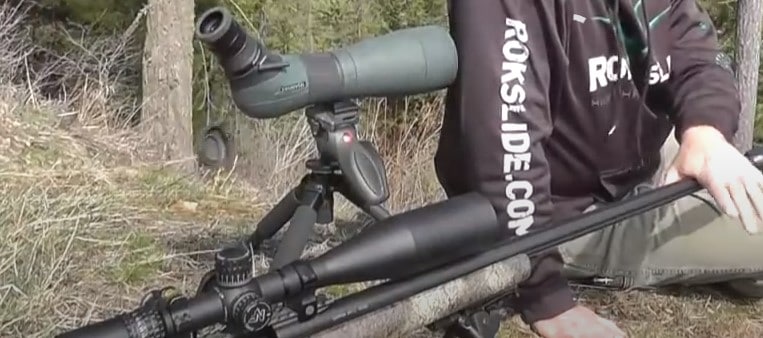Shooting in The Wind: How To Measure and Hit Your Target Effectively

Shooting in the wind is never fun; well, it can be fun once you know how to do it. I can’t recall how many times I’ve been on the rifle range on a bad day and still decide, “Hey, let’s shoot anyway.”
Poor weather conditions can make for poor marksmanship, and it does take real skill to score shot after shot when the wind is blowing. Here are a few steps you can take to conquer the wind and hit the bullseye, the buck, or the tin can.
Wind Speed
Let’s start by determining the wind speed. In order to accurately measure wind speed, it is always important to use a wind meter.
Some can estimate it by feeling alone, but a wind meter is always better. One of the best wind meters on the market would be the Caldwell Wind Wizard II, which is affordable and easy to use.
Wind Direction
As soon as we have determined wind speed, we need to determine the direction of the wind so that we can rate its impact on the bullet in flight.
According to the assigned value of wind from different clock positions, the following wind chart illustrates how different wind directions affect our firing solution. The shooter fires from 6 o’clock to 12 o’clock position, assuming the target is at 12 o’clock.
Wind Determination
The wind is an evil beast; to beat it, you must first have a good grasp on two wind factors, direction, and speed. The first step is to determine the direction and speed of wind before we can do anything else.
Direction can be determined by how the environment is moving around you. If your range has wind flags, it’s immediately apparent the direction, but if you’re in the field, you’ll need to use nature to your advantage.
Watch how the trees are moving, or grass, leave, or dust. From here, you can determine the direction the wind is blowing and prepare to compensate for it.
So, if the wind is coming from east to west, and you are facing North, you’ll need to aim east, so the wind will blow the bullet straight ahead. Simply put, the winds from the right will blow the bullet left, and vice versa. Speed can be determined by flags or nature as well.
If you can feel a light breeze on your face is between 3-5 miles per hour; if the leaves on trees are blowing and moving, it’s 5-8 miles per hour; if the dust is kicking up, it’s 8-12 miles per hour, and if small trees are bending and swaying the wind is between 12-15 miles per hour.
Wind Values
After you determine the direction and wind estimation, you need to place a value on your wind. Values work of what’s essentially a clock. Designed by the military, the value clock is an easy method to remember wind values.
Wherever your muzzle is pointing is considered twelve o’clock. If the wind is blowing from your twelve o’clock to your twelve o’clock to your twelve, you have no value, and a wind correction is not needed (0).
If the wind is between 10 and 11, 1 and 2, 4 and 5, and finally 7 to 8 on your value clock you have what’s considered a half value and will require a correction (0.5).
If the wind is coming from your 9 o’clock, or from your 3 o’clock this is a full value (1) and will require the most correction. It’s important to know what these values are to make an accurate holdover and, therefore, an accurate shot.
What About Mirage?
When we look at a target, we can see heat waves moving in our optics called mirages. You can learn crucial information about wind speed and direction by studying mirages.
You must see a mirage to determine the wind correction when you break the trigger in a headwind or tailwind situation. There is a temperature difference between the ground and the air on days when there is a lot of sunlight and mirage is likely to be visible.
Due to the sun’s ability to heat the ground better than dense green foliage, a bare dirt field or moved hay field will show a mirage better than a brushy hillside. It is sometimes necessary to search for the best place to look knowing this.
You will see a mirage differently depending on where you are and the terrain. For example, depending on the terrain, you may feel the wind traveling right to left if you are shooting in hills and gullies, but mirage will travel left to right if you are shooting at a target against a hillside.
The wind will be funneled around an obstacle, and if you do not realize it, you will miss it. Therefore, in a match, it is essential to pay attention to your surroundings and the terrain as well as the mirage.
Here Are Some Other Indicators Of Wind Direction
Many winds can be predicted by feeling and observation to within 1 mph by natural wind readers. They are highly aware of their surroundings, paying attention to things such as grass movement around the target, tree branch movement, impact dust kicked up by bullets hitting the dirt, and mirage.
Pay attention to your surroundings as the wind picks up and lets off and see the results on your wind meter as you are learning wind and using a wind meter for the first time. You will be able to better judge conditions by feeling and observing after gaining this experience.
Nuances And The Wind
It’s important to consider a few wind nuances, even if we’ve covered all the essentials. Aside from drifting your bullets, wind also pushes your body and can affect how steadily you hold your rifle. By physically blocking the wind and firing from the strongest support possible, you can minimize this problem.
Depending on the direction and speed of the wind, you may also encounter multiple winds. Watch how the wind is concentrated or turned by the terrain (especially hills and canyons) around you.
In addition to gusting winds, you may also see steady winds. You should time your shot to fire during a steady wind, which is usually more consistent and predictable.
When you face a near wind that is different from a far wind, time your shot for a calm nearby and compensate for the far wind. As a result, your bullet will have less time to drift before reaching its target in the far wind.
Your Holdover
A list of all the holdovers for all the calibers and barrel lengths would be impossible to list. I simply cannot do so. The list would be so extensive, with simple fractions of an inch difference.
However, you are in luck. Most ammunition manufacturers will publish this information online, and manufacturers like Hornady feature an easy-to-use ballistic calculator to give you an appropriate amount of holdover for a specific round.
Personally, I keep my wind dope for particular rounds written down and ready for the range. It’s a simple and easy method to guarantee I have the information necessary to make my shots.
It’s a very easy method to ensure I’m always on target. So, now pair your know-how with a quality rifle scope for long-distance shooting, and you cannot be bothered by wind anymore!

